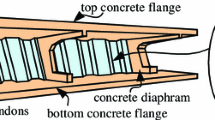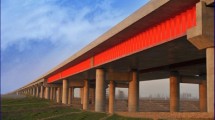Abstract
In the past two decades, there has been increasing interest in prestressed girders with corrugated steel webs in bridge construction. The objective of a recent study at the University of Calgary is two-fold. The first is to review and refine the theoretical background for the shear strength of corrugated steel webs. The second is to experimentally investigate the shear and flexural behaviour of composite prestressed I-girders made with such webs. The analytical study shows that the geometry of corrugated steel webs can be chosen to provide the highest shear strength for the least volume of steel with negligible sensitivity to small variations in the corrugation angle. Contrary to published data, the existence of an additional post buckling shear strength as high as 82% of the total shear strength was experimentally confirmed. The experimental results confirm that while the shear is supported by the corrugated steel web, flexure is almost entirely supported by the prestressing steel and reinforcing bars in the bottom flange in tension, and the concrete top flange in compression.
Résumé
Durant les deux dernières décennies, on reconnaît de plus en plus l’utilisation de poutres précontraintes avec âmes en acier ondulé pour la construction de ponts. L’objet d’une étude récente effectuée à l’université de Calgary est double. La première partie consiste à examiner et affiner les éléments de la résistance théorique au cisaillement d’âmes en acier. La deuxième concerne l’étude, à l’aide d’expériences, du fonctionnement en cisaillement et en flexion de poutres précontraintes en forme de I, fabriquées avec ces âmes. La partie analytique de l’investigation démontre que la géométrie des âmes d’acier ondulé peut être choisie afin de prévoir la plus grande résistance au cisaillement avec le moindre volume d’acier et une sensitivité négligeable aux variations de l’angle des ondulations. Contrairement à l’information publiée, l’existence de la résistance au cisaillement après le flambement de la poutre, qui peut atteindre 82% de la résistance totale au cisaillement, a été confirmée par des expériences en laboratoire. Les résultats des essais confirment que tandis que le cisaillement est supporté par l’âme en acier ondulé, la flexion est soutenue en tension par l’acier précontraint en prétension et les barres d’armature qui se trouvent dans l’aile inférieure, et en compression par le béton dans l’aile supérieure.
Similar content being viewed by others
References
Easley, J. T., ‘Buckling formulas for corrugated metal shear diaphragms’,Journal of the Structural Division, ASCE 101 (ST7) (July 1975) 1403–1417.
Hamilton, R., ‘Behaviour of welded girders with corrugated webs’, PhD Thesis Department of Civil Engineering, University of Maine, Orono, Maine, 1993).
Elgaaly, M., Smith, D. and Hamilton, R., ‘Beams and girders with corrugated webs’, Proceedings of NSF Structures, Geomechanics, and Building System Grantees Conference, San Juan, Puerto Rico, June 1992, 126–128.
Elgaaly, M., Hamilton, R. and Seshadri, A., ‘Shear strength of beams with corrugated webs’,Journal of Structural Engineering, ASCE 122 (4) (April 1996) 390–398.
Leiva-Aravena, L., ‘Buckling and strength of corrugated steel panels’, Thesis for the Degree of Licentiate of Engineering (Division of Steel and Timber Structures, Chalmers University of Technology, Göteborg, Sweden, 1987).
Leiva-Aravena, L., ‘Trapezoidally corrugated panels-Buckling behaviour under axial compression and shear’, Publication S 87:1 (Division of Steel and Timber Structures, Chalmers University of Technology, Göteborg, Sweden, 1987).
Luo, R. and Edlund, B., ‘Shear capacity of plate girders with trapezoidally corrugated webs’,Thin Walled Structures 26 (1996) 19–44
Johnson, R. P. and Cafolla, J., ‘Corrugated webs in plate girders for bridges’,Structures and Buildings 123 (May 1997) 157–164.
El Metwally, A., ‘Prestressed composite girders with corrugated steel webs’, MSc Thesis (Department of Civil Engineering, University of Calgary, Calgary, Canada, 1999).
Cheyrezy, M. and Combault, J., ‘Composite bridges with corrugated steel webs—Achievements and prospects’, in ‘IABSE Reports Vol. 60’, Proceedings of IABSE Symposium: Mixed Structure-Including New Materials, Brussels, 1990, 479–484.
Naito, T. and Hattori, M., ‘Prestressed concrete bridge using corrugated steel webs—Shinkai Bridge’, Proceedings of the XII FIP Congress, Washington D. C., 1994, 101–104.
Hondani Bridge, ‘Construction Drawings-English Version’ (Japan Highway Public Corporation 1998).
Galambos, T.V., Editor, ‘Guide to Stability Design Criteria for Metal Structures’, 4th Edn. (John Wiley & Sons, New York, 1988).
Author information
Authors and Affiliations
Rights and permissions
About this article
Cite this article
El Metwally, A., Loov, R.E. Corrugated steel webs for prestressed concrete girders. Mat. Struct. 36, 127–134 (2003). https://doi.org/10.1007/BF02479526
Received:
Accepted:
Issue Date:
DOI: https://doi.org/10.1007/BF02479526




